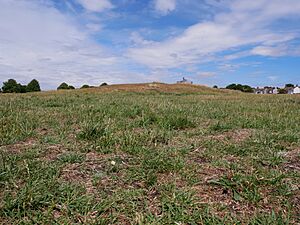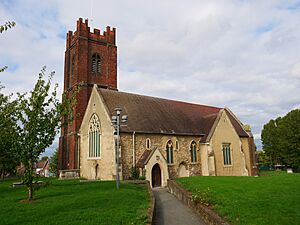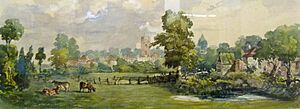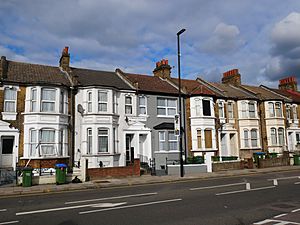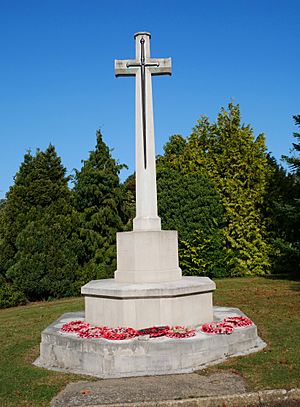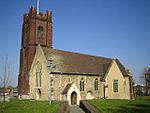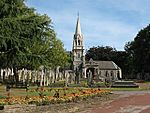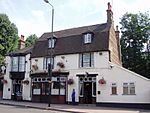Plumstead facts for kids
Quick facts for kids Plumstead |
|
|---|---|
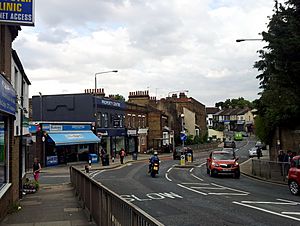 Plumstead Common Road in 2015 |
|
| Population | 16,736 (2011 Census Ward) |
| OS grid reference | TQ445785 |
| London borough | |
| Ceremonial county | Greater London |
| Region | |
| Country | England |
| Sovereign state | United Kingdom |
| Post town | LONDON |
| Postcode district | SE18 |
| Dialling code | 020 |
| Police | Metropolitan |
| Fire | London |
| Ambulance | London |
| EU Parliament | London |
| UK Parliament |
|
| London Assembly |
|
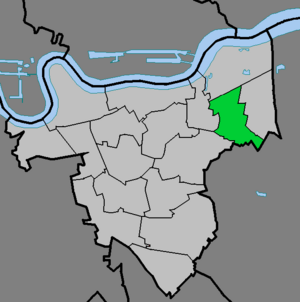
Plumstead is a part of southeast London, located in the Royal Borough of Greenwich, England. It is found to the east of Woolwich.
Contents
Plumstead's Past: A Look Back in Time
Plumstead has been lived in for a very long time. The oldest timber structure ever found in London was discovered here. In 2009, archaeologists found an ancient wooden trackway near Belmarsh Prison. This trackway is almost 6,000 years old!
In 960, King Edgar gave four pieces of land, called Plumstead, to St Augustine's Abbey near Canterbury. Later, Earl Godwin took these lands for his son, Tostig.
After King Edward the Confessor became king, he gave the lands back to the monastery. But when Edward died in 1066, Tostig tried to take them again.
After the Battle of Hastings in 1066, William the Conqueror gave Plumstead to his half-brother, Odo, Bishop of Bayeux. The Archbishop of Canterbury and the abbot of St Augustine's managed to get some of the land back for the monastery.
The Domesday Book of 1086, a famous survey of England, lists Plumstead in two parts. It shows that the abbot of St. Augustine's and the Bishop of Bayeux both held land here.
Over the years, different people had claims to the land in Plumstead. In 1287, Lora de Ros gave her rights to land and woods in Plumstead to the abbot. This was in exchange for prayers for her and her family.
In 1314, during the time of Edward II of England, the abbot was asked to show his rights to hold a weekly market in Plumstead on Wednesdays. He also had rights to a yearly fair for three days around St. Nicholas' Day.
For unknown reasons, King Edward III said that Plumstead residents only had to send one man to the sheriff, instead of the usual four. This was a special rule for Plumstead. In 1363, King Edward also confirmed all the special rights and lands given to the monastery by earlier kings.
By the time of Richard II of England, the taxes from Plumstead were quite valuable. Henry VI of England also confirmed the monastery's rights.
Plumstead manor and its church stayed with the monastery until 1539. This was when King Henry VIII closed down many monasteries. The abbot, John Essex, gave the abbey and all its lands, including Plumstead, to the King.
Plumstead grew very quickly in the 1880s. Many houses were built for workers at the Royal Arsenal. Smaller terraced houses were built near the river. Larger homes were built further up the hill, near Plumstead Common. The Plumstead Common Act 1878 made sure that Plumstead Common would always be a public open space.
Plumstead was also home to some religious groups, like the Peculiar People and the Plymouth Brethren. Quakers also met nearby.
Even with all the new houses, Plumstead kept many green areas. These include Winns Common, Plumstead Common, Shrewsbury Park, and Rockcliffe Gardens.
Learning in Plumstead: Schools and Education
Plumstead Manor School is a well-known school in the area. It started as Plumstead County School for Girls in 1913. It later became a comprehensive school in 1967. The school was only for girls until September 2018, when it started welcoming students of all genders.
There are also many primary schools in Plumstead. These include St. Patricks RC Primary School, St. Margaret's CofE Primary School, Gallions Mount Primary School, Timbercroft Primary School, Bannockburn Primary School, Plumcroft Primary School, Greenslade Primary School, South Rise Primary School, and Conway Primary School.
Sports History: Football in Plumstead
Arsenal Football Club used to play in Plumstead! When they were known as Royal Arsenal or Woolwich Arsenal, they played here between 1886 and 1913. They played at different grounds, mainly the Manor Ground and the Invicta Ground.
Getting Around: Transport in Plumstead
Rail Travel
Plumstead railway station connects the area to other places. You can catch National Rail trains to London Charing Cross (via Lewisham), London Cannon Street (via Greenwich, Bexleyheath, or Sidcup), Kentish Town (via Greenwich), Dartford, and Rainham.
Bus Services
Plumstead has many bus routes run by Transport for London. These buses connect Plumstead to areas like Bexleyheath, Central London, Crystal Palace, Dartford, Eltham, Erith, Greenwich, Lewisham, New Cross, Orpington, Peckham, Sidcup, Thamesmead, Welling, and Woolwich.
Famous Faces: People from Plumstead
Many interesting people have come from Plumstead, including:
- Ethel Edith Bilsland, a composer, singer, and pianist
- Michael Bradshaw, an actor
- Charlie Buchan, a footballer and writer
- Mason Burstow, a footballer
- John Carnell, a science fiction magazine editor
- Stephen Lawrence
- George Chakravarthi, an artist
- Ernest Clark, who was the Governor of Tasmania
- Charlie Collier, a motorcycle racer
- Dave Courtney, an author
- Steve Davis, a snooker player
- Tanya Franks, an actress
- Fred Hammill, a trade union leader
- Kevin Horlock, a footballer
- Marvin Humes, a member of the boy band JLS
- Malvin Kamara, a footballer
- Scott Maslen, a television actor
- Taiwo Owatemi, a Member of Parliament (MP)
- Lee Ryan, a member of the boy band Blue
- Tinie Tempah, a rapper
- Nina Toussaint-White, a television actress
- Paul Walsh, a footballer
- Bill Whitehouse, a Formula 1 racing driver
- Shampoo, a pop music duo
Some notable people are buried in Plumstead Cemetery, such as:
- William Bennet (bishop), a bishop from Ireland
- Thomas Flawn VC (a Victoria Cross recipient)
- Edwin Hughes MP (a Member of Parliament)
- Alfred Smith VC (another Victoria Cross recipient)
Places Nearby: Exploring Plumstead's Neighbors
- Abbey Wood
- Belvedere
- Blackheath
- Charlton
- East Wickham
- Greenwich
- Shooters Hill
- Thamesmead
- Welling
- West Heath
- Woolwich
- Bexleyheath
Gallery
See also
 In Spanish: Plumstead para niños
In Spanish: Plumstead para niños



